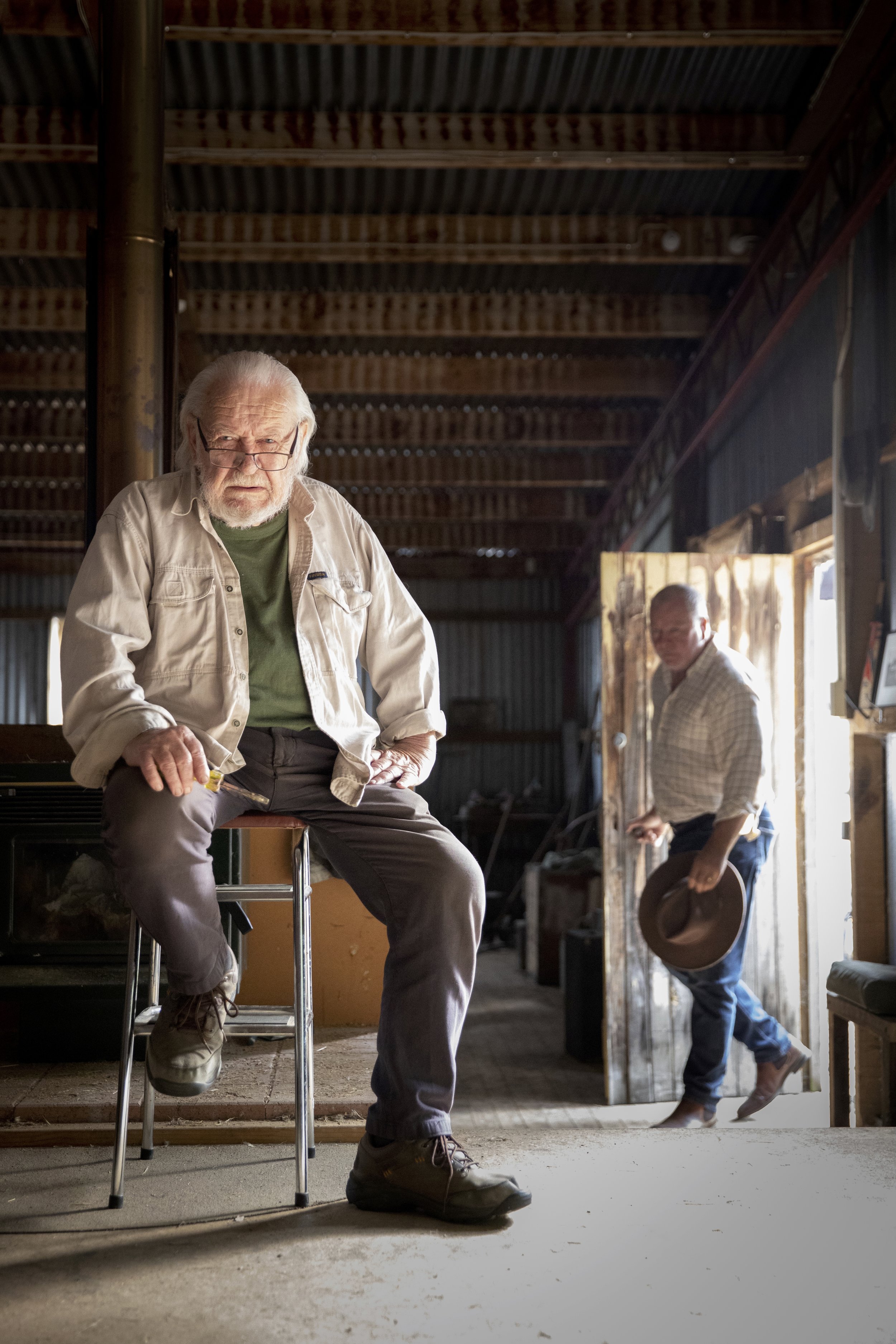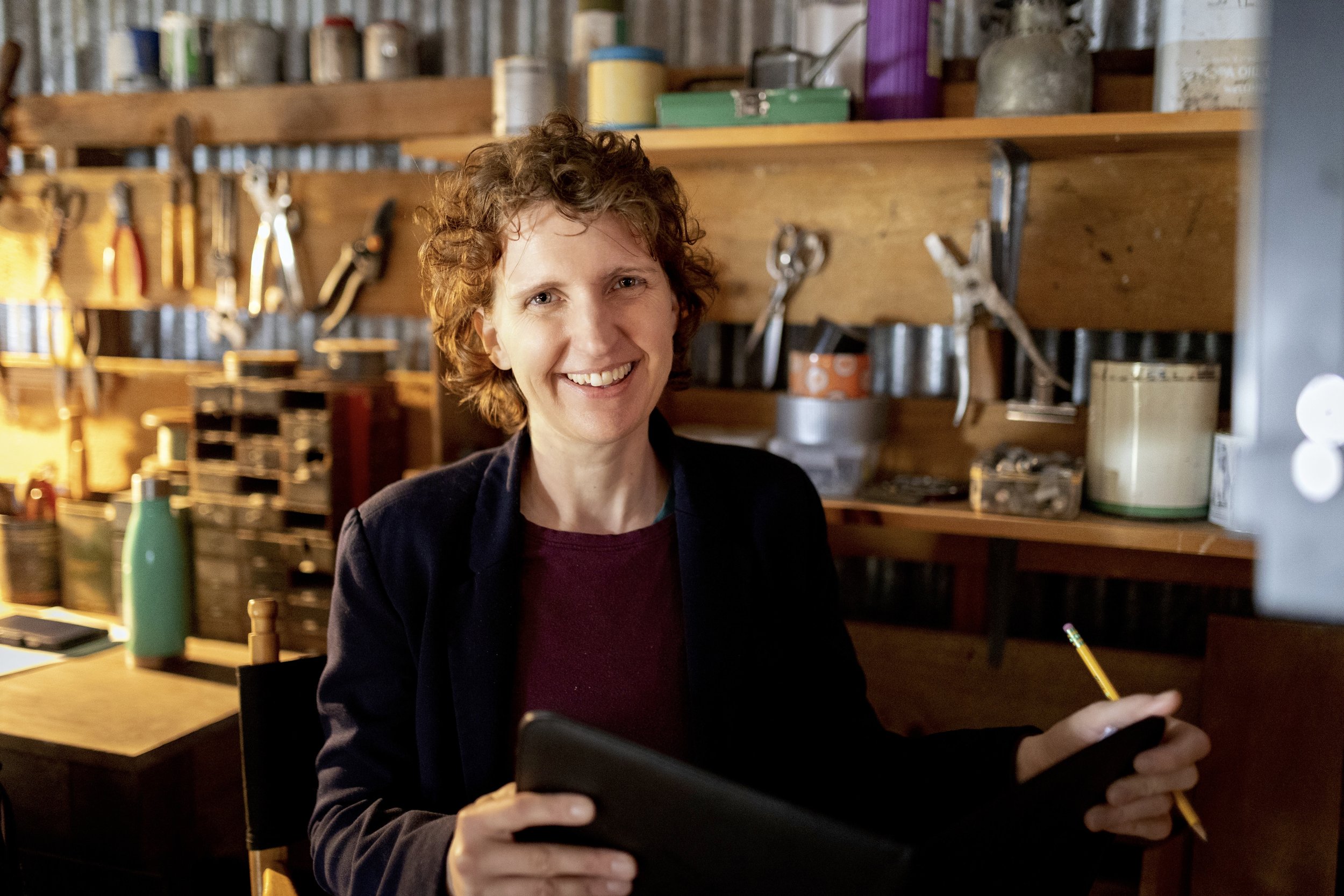Spotlight Interview: Elinor Teele & Pulling Up Stumps
Elinor Teele is a versatile storyteller whose work spans novels, screenplays, and now short films. Her recent directorial debut, Pulling Up Stumps, is a New Zealand short film featuring Ian Mune and Mark Mitchinson, with cinematography by Alun Bollinger NZCS. Set amidst the dust and shadows of a Central Otago woolshed, the film tells the story of a grumpy old man who is obliged to listen to a humorous tale from a meddlesome stranger.
We had the opportunity to sit down with Elinor to discuss her creative process, inspirations, and upcoming projects.
Q: What inspired the idea for Pulling Up Stumps, and how did it evolve during the writing process?
Pulling Up Stumps is inspired by a true story. My Yankee grandfather loved to tell the tale of an obstinate stump in his meadow, the arrival of a helpful neighbour, and their unique & explosive solution.
When I moved back to Otago, I decided to adapt this story to suit the environment. Yankee men and Southern farmers have a similar no-nonsense approach to life! I called upon a number of Lakes District farming neighbours and family friends to vet the details.
During the script editing process, I also had the help of the wonderful Kathyrn Burnett, who helped me refine a few of the key moments when all hope seems lost.
Finally, in the edit, the script changed again. Through discussions with my fabulous editor, Shane Loader, we realised that we could shave bits of dialogue off and rely more heavily on the actors’ looks and expressions. Initially, the script had a more comic feel. However, through editing, it became a poignant haiku.
Q: How would you describe the film’s concept in your own words?
The concept of the film is “moments.” Think of a dust mote drifting past a window. If it turns just the right way, the sunlight catches it, and it gleams silver and gold. Then, just as quickly, it fades back to a dull brown.
That’s what we were trying to capture in the film—those golden moments of life that you only experience every now and then with your loved ones. And you treasure them in your memory because they are so rare.
Q: Why did you choose the setting of a woolshed in Central Otago? What does it bring to the story?
The alternative approach would have been to recreate the story outside. A tempting—if somewhat perilous—choice!
But I wanted the audience to stay focused on the internal journey of Ian Mune’s character. The woolshed is his place of safety and a touchstone for his entire life as a sheep farmer. It’s the one spot that still remains familiar as his memory fails him.
We had so many people help us populate the shed with authentic tools and vintage equipment! There are old-fashioned traps, maps, shearing items, and more. If you look closely at the background objects, each one provides clues to what farming life was once like.
Q: Can you walk us through your approach to writing and directing a short film like this?
When I was writing the script, I wanted to give the film a definitive beginning, middle, and end.
The key question is whether Ian Mune’s character will remember the man who’s sitting next to him. So we first had to introduce Ian’s character and the intrusion of Mark Mitchinson’s character, followed by the telling of the story (and a gradual realisation of why it’s being told), followed by Ian’s character finally seeing the light.
Since this was my first time directing, I kept it very simple: one set, two actors, under 15 minutes. I knew I was going to be learning a lot on the job, so I didn’t want to get too overwhelmed by logistics.
Fortunately, I had amazing support from my co-producers, Emma Martini (FrameUpMedia) and Phillida Perry (Perrys Road/Daughter), as well as our executive producer, Brett Mills of the Queenstown Camera Company and the entire cast & crew.
Ian Mune and Mark Mitchinson // Photo Credit: Still Vision Photography
Q: How did you collaborate with Ian Mune and Mark Mitchinson to develop their characters?
We had two online workshops with Ian and Mark before they arrived on set. Even though I knew the blocking would change on the day, I wanted to hear the rhythms of their speech and their ideas about the characters’ motivations.
It also gave us a chance to talk about our own experiences of family and memory loss, which added an extra layer of emotional resonance when we were filming.
Q: What was it like working with Alun Bollinger to bring your vision to the screen?
Alun Bollinger, MNZM, NZCS is a cinematographic titan in the New Zealand film industry. He’s the man behind the camera for many classics of Kiwi cinema, including HEAVENLY CREATURES.
But with me, he was simply AlBol. And I loved getting on the phone with him to talk about the superiority of Arri cameras (“the Germans do it best”) and the framing of classic Hollywood westerns.
AlBol—and our gaffer, JoBol—also instinctively understood what I was going for with the lighting. You’ll notice that the entrance of Mark Mitchinson’s character is all cold blues and greys.
But as the men grow closer in both physical & emotional proximity, the world becomes suffused with the gold from the work lamp and the kitchen scales. Until finally, when Ian Mune’s character has had his revelation, we flood the woolshed with sunshine.
I told AlBol when I saw the film cut together that it was like looking at a painting by Rembrandt.
Planet 13 Cast: Luna Blanco and Jordan Rivers
Q: The film has been described as having a ‘slow cinema’ aesthetic. What drew you to this style, and how does it reflect the story?
I adore subtle movies that live quite happily in the shadows of their noisy, blow ‘em up siblings. (Looking at you, Marvel.) I’m thinking of films like David Lynch’s THE STRAIGHT STORY, Robert Redford’s A RIVER RUNS THROUGH IT, and Wim Wenders’s PERFECT DAYS.
I call this genre “Quiet Cinema.” These films expect a lot of an audience—you have to concentrate—but they reward their viewers with a huge amount of emotional heft. Even the slow and quiet moments in life can be dramatic.
Q: Pulling Up Stumps deals with themes of aging and human connection. Why do you think these themes resonate today?
There’s a massive generation that’s saying goodbye to the world now, and many folks are dealing with the loss of grandparents and parents.
But we’re also saying goodbye to ways of life. Technology has cut us off from getting our hands dirty, from talking to someone face-to-face, from taking the time to simply sit with someone we love in silence.
PULLING UP STUMPS is elegiac because it’s capturing the fleeting moment before this world is gone.
Q: Were there any standout moments or challenges during production that shaped the final film?
You’d have to ask the cast and crew for their opinions, but I had a blast during production. We had the usual run of challenges—finicky props that kept breaking, cold in the mornings and heat in the afternoons, the threat of rain on a corrugated iron roof ruining the sound—but nothing that interfered with the final film.
One of the most comic challenges was getting our special star, Giovanni the Rooster, to do anything but simply stare at the cameras and shrug. Giovanni has the full run of the Queenstown Camera Company yard, so he’s completely comfortable with being around lots of people and equipment. We were lucky to get his signature entrance!
I also loved finding tiny moments with Bradley Willemse, our First Assistant Camera. Take a look at when Ian Mune’s character reaches for his trusty screwdriver and can’t find it. There’s a focus pull on the word “Craftsman” that goes from sharp to fuzzy. Just like the character’s mind.
Q: Can you share a story from the set—perhaps something unexpected or particularly meaningful?
I have a few golden memories. The first was watching Ian and Mark lock into their characters. We had done a few shots from various angles, but in this particular instance they were so engaged in their connection that they made me cry.
Another meaningful memory happened on Saturday afternoon, when we suddenly needed to move rapidly through a series of shots. The crew were beautiful to behold in that moment. It was like watching a dance.
I also loved my conversations with our student runners, the Jack’s, and our clapper loader, Rudi Beavan. Even though we decided against including an exterior shot for the finale, seeing Jack Smillie holding a state-of-the-art camera at the top of Tobin’s was worth the trip.
Q: Pulling Up Stumps feels deeply connected to New Zealand. How does the local landscape and culture influence your storytelling?
I love the Central Otago area and the people in it. They have a rhythm and a cadence and an approach to life that you won’t find anywhere else. Farmers battle violent snowstorms in the winter, torrential rain in the spring, and blinding heat in the summer. And they take their knocks without complaint.
PULLING UP STUMPS had to be set in this area. No other world made sense.
What’s next for you after this project? Can you share more about Central Uncovered or other upcoming work?
I’m working on a number of projects—some domestic; some international. This summer, I’m finishing the draft of NEW WORLD SYMPHONY, a musically charged, coming of age Melbourne/Kiwi feature that’s about two comic and artistic souls.
I have a couple of low budget Aotearoa NZ short films, including CENTRAL UNCOVERED, that may stay as shorts or blossom into full-length features (time will tell).
And I’m in the early stages of two international animated features that I’m very excited about. It’s too early to give an update on those, but it’s a space where I want to spend time. I love the visual freedom of animation.
Q: Who do you hope will see this film, and what do you hope they’ll take away from it?
I hope fathers and sons will see this film, since it was designed with them in mind. But I’m always pleased to have anyone watch it and identify with it. If folks can see their own story in the tale and the telling, then we’ve done our job.
What they take away from it is up to them!
Q: If you could give one piece of advice to someone creating their first short film, what would it be?
Plan, plan, and plan some more—especially in pre-production. That planning includes meeting individually with crew members and asking for their wisdom on what could go wrong; walking through your locations multiple times and sussing out the light, the angles, and your shots; thinking about how the order of your shots each day affects the actors and crew (nobody’s wide awake after lunch); making sure that your choice of shot gives an extra layer of meaning to what’s being said or done…
I could go on and on, but the gist is—try to troubleshoot as much as possible before filming. You’re always going to have unexpected issues crop up on shoot days, but it’s easier to deal with them if you’ve planned ahead.
Thank you, Elinoor, for sharing your journey behind Pulling Up Stumps and giving us a deeper look into the heart of this film.
If you haven’t seen it yet, you can watch Pulling Up Stumps here: https://www.youtube.com/watch?v=CZn3EobM1ek













